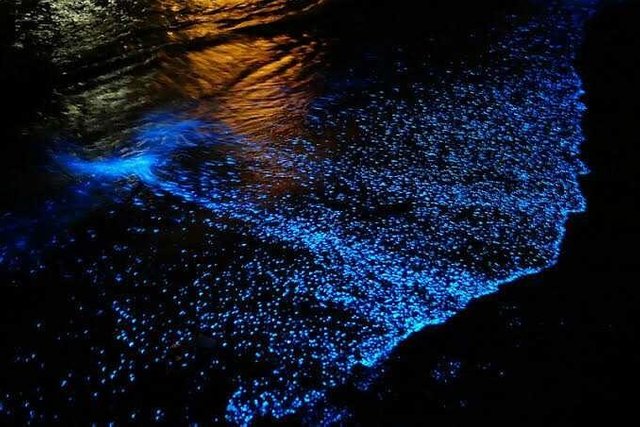
Luminous plankton beach
if you stand upon the beach of Torrey Pines, simply north of san diego, you'll witness a stunning exhibition of colours reserved for a choose few. below the gaze of the moon, the ocean waves seem a deeper blue than normal. A soft light seems to coast on the tides, draping the sands in their brilliance. blinking upon the shores repeatedly, this strange development began solely in early may of this year. luminescent ocean waves have additionally been discovered in Belgium, Boracay and Phu Quoc island in Vietnam.
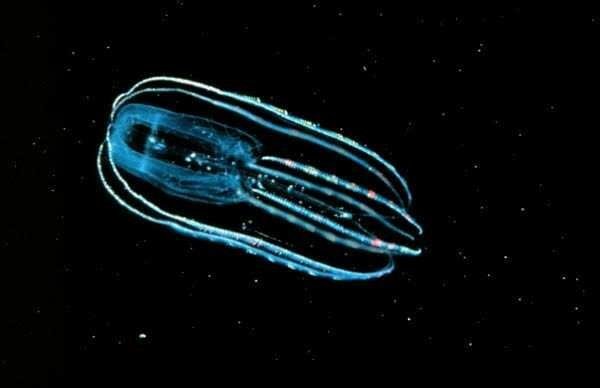
Plankton
This blue luminescence is caused by a particular species of organism, little creatures that dominate the world’s oceans and lie at rock bottom of the food chain. These planktons emit the soft, stunning blue light as a result of a chemical action that's happening within them caused by chemicals known as luciferins a similar chemical process is accountable for the good glow of a firefly’s lower abdomen.
Luminescence is plenteous in nature — creatures with this rare ability are discovered on rocks, in caves and within the darkest depths of the oceans.
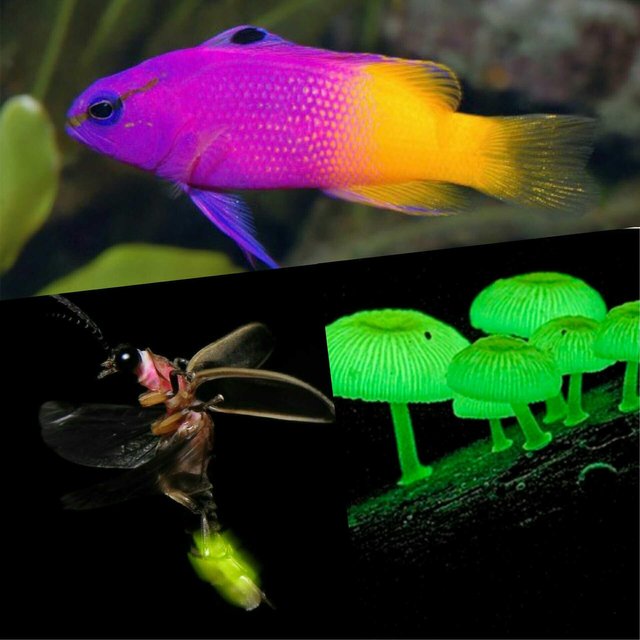
Right: Foxfire in the fungus Panellus-stipticus . Top: A fish with luminescent scales. Left: A firefly with a luminescent lower abdomen
In the early 1960s, a scientist by the name of Osamu Shimomura noticed an exact species of jellyfish off the coast of Washington state, referred to as Aequorea victoria that also glowed with an excellent, wealthy shade of green, however only if shone upon with ultraviolet (UV) light. Shimomura isolated the protein accountable for the attractive green colours he observed and competently named it green Fluorescent protein, or GFP. The GFP found within the Aequorea Victoria jellyfish is extremely faint and tough to notice, however is kind of striking once these jellyfish clump together in giant teams.
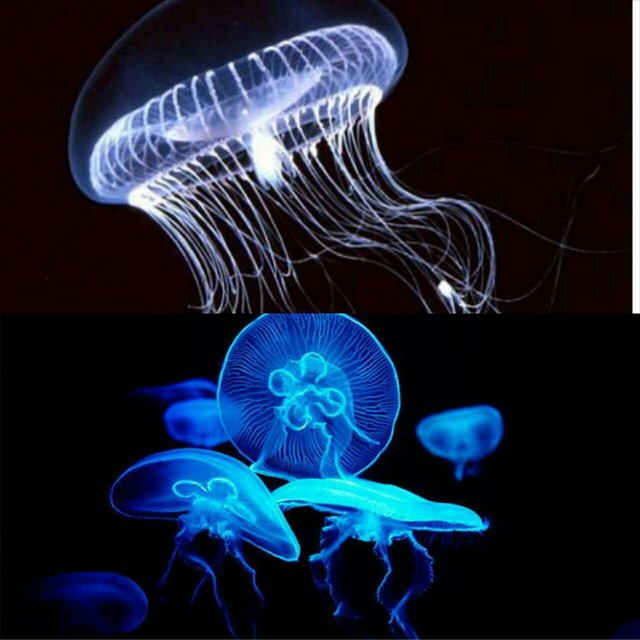
Aequorea victoria jellyfishTop and group of jellyfish emitting soft blue, bioluminescent light Below
About thirty years later, within the 1990s, glowing creatures off the coast of San Diego once more found their means into the mind of a soul. Roger Y. Tsien a prof at the University of California — San Diego, stood in awe of the luminescent ocean waves of southern California one night. The ocean waves crashed upon the sand and retreated inexhaustibly, the bioluminescent plankton floating upon the tides. during this moment, an inspiration was born that will end up revolutionizing nearly each space of science.
Roger Tsien began his scientific training at Harvard school, where he graduated with degrees in Chemistry and Physics. Tsien then moved to the University of Cambridge, finishing his pH.D. in Physiology in 1977 below the management of prof Richard Adrian. In 1982, Tsien was appointed to the college of the University of California, Berkeley and, seven years later, was a professor of pharmacological medicine at the University of California, San Diego.
In 1995, Tsien’s laboratory published what would ultimately become one among the foremost prestigious scientific work of all time. Since the GFP discovered by Shimomura was too faint to be simply detectable within the laboratory, Tsien and his team of scientists needed to work out the simplest way to increase the amount of fluorescence emitted by the protein. Miraculously, they found that by changing one amino acid within the protein, a serine at position sixty five, GFP emitted light at 470–490nm and was four to 6 times brighter than the GFP found in nature. This study, authored by Roger Heim and Andrew B. Cubitt and led by Roger Tsien, was revealed within the journal Nature in Feb of 1995. It lit a flurry of analysis in different laboratories, as scientists discovered that they might fuse GFP to alternative proteins then track how proteins in a living cell moved in beautiful detail.
GFP has been united to proteins in neurons to review how neural transmission works, has elucidated the proteins concerned in cellular division and has been utilised in many different applications of research, enabling scientists to watch cellular processes at A level of resolution that had never before been attainable.
The following year, in 1996, scientists round the world frantically disorganized to work out specifically how the GFP protein manages to emit light of an outlined wavelength below {uv|ultraviolet|ultraviolet radiation|ultraviolet light|ultraviolet illumination|UV|actinic radiation|actinic ray} light. One laboratory, led by S. James Remington , managed to extract the DNA encryption GFP from the Aequorea Victoria jellyfish and place it into E. coli, a typical kind of bacteria. The E. coli began to supply the GFP in massive quantities, that enabled Remington and different scientists to extract a major quantity of GFP and solve its structure employing a technique referred to as x-ray crystallography
A crystal structure for GFP emerged, during which an amino acid barrel encloses a central chromophore, that is solely a brief chain of amino acids liable for the coloration of the protein. once light of a particular wavelength strikes the GFP, the central chromophore changes in form and emits light at an outlined wavelength.
Once Tsien examine Remington’s results and determined the crystal structure for himself, it was shortly before he totally grasped the principles for fluorescent proteins and could begin planning unnatural versions. within the years that followed, Roger Tsien’s laboratory at UC-San Diego managed to change GFP into a rainbow of alternative colours, from deep reds to rich yellows and sparkling purples. All of those totally different colours may be created by modifying just a couple of amino acids within the proteins.
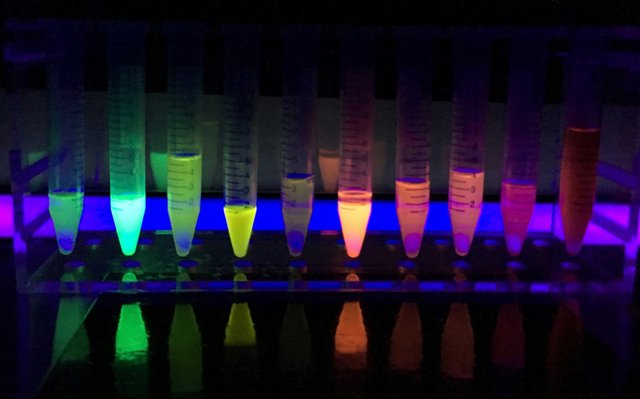
A look at some of the fluorescent proteins created by Roger Tsien, demonstrating a brilliant palette of colors.
As a result of the microscopy studies that were currently attainable due to Tsien and his palette of various fluorescent proteins, he shared the 2008 Nobel prize in Chemistry with Martin Chalfie and Osamu Shimomura. Chalfie had been among the first to demonstrate the utility of GFP in cellular biology; in a currently classic study, Chalfie managed to express GFP in a worm, called C. elegans , to review individual cells within the organism.
Tsien tragically died in 2016 at the age of sixty four, however his gift lives on within the thousands of laboratories that use his colourful tools to check cellular biology on a daily basis.
Today, scientists the globe over still create biological discoveries with the help of GFP and alternative fluorescent proteins. Every year, new fluorescent proteins are created as well as, recently, proteins that glow within the infrared range of light.
Tsien, Shimomura and Chalfie demonstrated how a similar good glowing lights in fireflies, jellyfish, rocks and caves is exploited to study the very underpinnings of life, altogether its complexity and wonder.

An agar plate streaked with bacteria that express different fluorescent proteins. Made by Roger Tsien himself.
References :
Great post @stevendion but there is is an unsung hero in the GFP story that many people miss and this person is Douglas Prasher. He was the scientist who cloned and published the sequence of the GFP gene. Unfortunately, his funding ran out in 1992 and he left academia. But his cloning of the GFP gene was instrumental for Marty Chalfie and Roger Tsien success with using GFP as an in vivo reporter.
Cheers!
ian
Downvoting a post can decrease pending rewards and make it less visible. Common reasons:
Submit
Could you help me on my blog? I'll help you too!
Downvoting a post can decrease pending rewards and make it less visible. Common reasons:
Submit
@resteemator is a new bot casting votes for its followers. Follow @resteemator and vote this comment to increase your chance to be voted in the future!
Downvoting a post can decrease pending rewards and make it less visible. Common reasons:
Submit